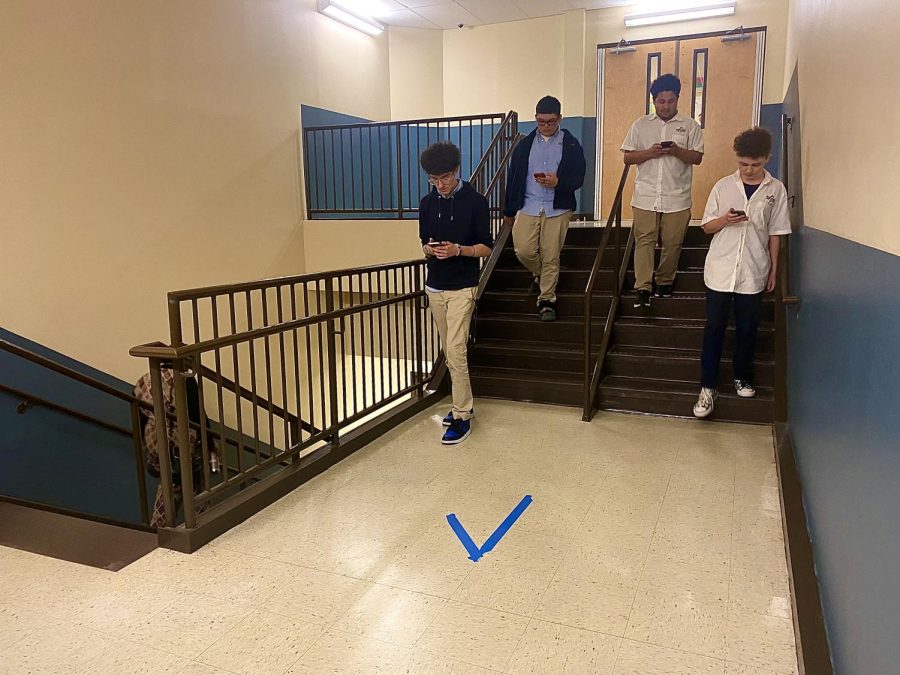One Way Only: The New Traffic Policy
Students and teachers share their viewpoints on the new traffic policy
March 30, 2023
There have been mixed feelings about the new traffic hallway and stairway policy implemented on March 6. The policy has affected teachers, students, and more.
“So, we have what is called the education model here. The outside ring of the education model is called conditions for learning and that pretty much means that the flow of students coming in and out of classrooms directly affects the instructions going on in the classroom. So that causes kids to be frequently late and get caught up in traffic which makes them miss instruction time and they lose their instructional opportunity. So, we want to clean up those operations, get kids quicker from A to B not only quicker, but more fluid-like so it would help the instruction be stronger,” Principal Joseph Childers explained.
Childers has seen many benefits following this new protocol. One benefit that Childers has seen relates to scheduled bathroom times and E-Hall passes. He finds this as an easier way to find students and track their history.
“We have had way less bathroom issues, I see kids where they are supposed to be more often. M y teachers are using E-Hall passes so it is easy to track because what happens a lot of times is kids will be messing things up and the entire group gets held, gets punished for it. But if I can hone it in to make sure we are able to monitor the kids with more fidelity, it makes life easier for you. You may not like that you cannot go to the bathroom in between passing periods, but you are still allowed to go to the bathroom, just in a more structured way,” Childers said.
Students also have strong opinions on this new policy. Sophomore Tanya Peña has a strong negative view on the policy and explains how it affects her everyday life during transitions.
“It is pretty confusing because whenever I come out of lunch, I always go to the stairway that I used to go to for going upstairs and then when I see the sign, it only says, ‘downstairs only’ and then I have to go the other way to go to the upstairs stairway,” Peña wrote.
Although she does have a negative view on the policy, Peña is more upset with the timing of this policy. Peña also believes that detentions are not appropriate for not following this policy.
“I do not believe it is a better policy for many reasons. It is a waste of time, students are rushing, bumping into each other in the hallways. We are getting in trouble for something that the school is incorporating us to do that. They should have done this from the very beginning and not waste time trying to show us a new way of doing things when this should have been in the program from the very beginning, so that everybody was on the same page,” Peña wrote.
Other students have a more neutral-based opinion on the new policy. Junior, Anthony Martinez explains how he sees the new policy not making major changes.
“I think it’s okay. I feel like most people were getting to class on time without it, but it does establish some sort of border so I kind of agree with it,” Martinez said.
Most students found it difficult to go to their classes on time due to congregations and students using the bathroom. This is one reason why Martinez found borders and one-way hallways a bit useful as well as closing the middle hallway.
“That’s kind of fair honestly. A lot of congregations were happening in that middle hallway, and it was almost unable for anyone to use the bathroom entirely because of that so I see why they did that. It’s understandable,” Martinez said.
Some students start to struggle with the one way only policy when getting to class. Sophomore David Rivera is one of those students who struggle with the one-way policy and the middle hallway being closed.
“It’s understandable during transitions because of how many kids are usually there but that combined with the one way just make it harder to get to classes,” Rivera said.
Rivera believes that the new policy makes transitions even worse. He struggles with more crowding in the hallway than usual and more traffic around the stairwells.
“It makes hallways more crowded, and they got rid of the shortcut to get to classes. I think that we’re better off without the new policy because there is only two up stairwells and one down stairwell so along with the middle hallway being blocked off and there is a one way and all of that combined doesn’t really help with class transitions,” Rivera said.
In response to the new policy, Sophomore Addison Caputo created and turned in a petition for a two-way hallway and stairway policy instead. They got over 100 signatures for the petition along with more signatures from middle school students.
“I thought about how much of an inconvenience it was for most kids. If you have a class next to one another, you have to go all the way around and that is a very big inconvenience. I understand the flow is a lot faster, but it is just a really big inconvenience for having two classes next to each other,” Caputo said.




